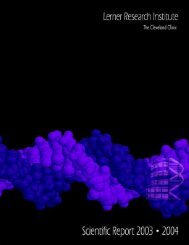The Lerner Research Institute Notations - Cleveland Clinic Lerner ...
The Lerner Research Institute Notations - Cleveland Clinic Lerner ...
The Lerner Research Institute Notations - Cleveland Clinic Lerner ...
- No tags were found...
You also want an ePaper? Increase the reach of your titles
YUMPU automatically turns print PDFs into web optimized ePapers that Google loves.
State of LRIContinued from page 1• <strong>The</strong> <strong>Institute</strong> has made more than adozen key appointments for research.• NIH program project grants supportwork in areas of atherosclerosis,interferon and cancer, multiple sclerosis,thrombosis, inflammation,bone marrow failure, ischemic heartdisease, and orthopaedic research.• <strong>The</strong> LRI now focuses on cardiovascular,cancer, neurologic, musculoskeletal,allergic/immunologic,eye, metabolic, and infectious areasof disease study.• New spin-off companies continue todevelop the research undertaken atthe LRI; for example, PrognostiX,for diagnostics; and <strong>Cleveland</strong>BioLabs, for anti-cancer and radioprotectiondrugs.Also, the LRI is opening the newGenetics and Stem Cell <strong>Research</strong>Building this winter (see story on page 7),and is currently searching for chairs tolead the two new departments of humangenetics and stem cell biology. This willplace the LRI among the elite in the newerfields of genetics and stem cell research.“<strong>The</strong> words of George Crile at theopening of the first <strong>Clinic</strong> building in1921 are as important today as they werethen,” said Dr. DiCorleto. “Dr. Crile said,'It is through the <strong>Cleveland</strong> <strong>Clinic</strong>Foundation ... that a continual policy ofactive investigation of disease will beassured. That is to say, we are consideringnot only our duty to the patient of today,but no less our duty to the patient oftomorrow.'”Li and QianContinued from page 5to study how Act1 may affect otherimmune cells, especially dendritic cells(these cells detect the invadingpathogens), since CD40- and BAFFRmediatedsignaling pathways also play acritical role for dendritic cell maturationand activation. Another avenue of investigationis to see if Act1 modulates or influencesother CD40- and BAFFR-relatedreceptors in the tumor necrosis factor(TNF) superfamily. <strong>The</strong>y will investigatewhether or not Act1 influences immuneresponses and development autoimmunediseases through its function in multiplepathways and multiple immune cells.“<strong>The</strong> molecular mechanisms ofautoimmunity are not well understood,”said Dr. Li. “This is important to the basicunderstanding of the autoimmune diseaseprocess as well.”Five years in length, the researchproject received its initial seed fundingfrom <strong>The</strong> <strong>Cleveland</strong> <strong>Clinic</strong>, and Drs. Liand Qian hope to attract funds from theNational <strong>Institute</strong>s of Health. Also, theremay be interest by some biotech companiesin their Act1 knockout mice.Nanomedicine SummitContinued from page 11fabrication strategies. Dr. Roy explainedthese concepts of making nanodevices orsystems this way: “top-down” methodstake an existing technology, like lithography,and refine it down to the 1-100 nmscale; “bottom-up” techniques, such asmolecular self-assembly, operate at the fundamentalchemical level and rely on the stabilityfrom molecular thermodynamics toachieve creations at the 1-100 nm scale.Technology on the nanoscale is rapidlydeveloping and encompasses microsensorsfor rapid and sensitive diagnosis,nanoparticles for highly targeted drugdelivery to tumors, and patterned chips(substrates of glass or specialty plastics)for investigation of biological phenomena.Leading off the summit were DerekRaghavan, M.D., chairman of <strong>The</strong><strong>Cleveland</strong> <strong>Clinic</strong> Taussig Cancer Center,and Harold Craighead, co-director of theNanotechnology Center at CornellUniversity, the event's plenary speakers,addressing cancer diagnosis and therapyand nanotechnology appraisal, respectively.Other experts described how theoreticalsolutions to medical problems and testingsystems are reduced to practice in devicemanufacturing and in relation to the pharmaceuticalindustry.Support for the summit came from anarray of government, industry and privatesources and totaled more than $100,000.Reflecting on the success of the summit,Dr. Roy said he found the intense levelof interest in general and the high level ofenthusiasm of <strong>Clinic</strong> participants especiallygratifying. “<strong>The</strong> key to making nanotechnologytechniques relevant to clinicalneeds -- and this is what we want -- is todiscern what is scientifically plausiblefrom what is actually impossible,” he said.<strong>The</strong> 12th International Workshop on HIV Dynamics andEvolution will be held April 23-26 at theInterContinental Hotel and Conference Center<strong>The</strong> workshop provides a regular forum for specialists inHIV variation and pathogenesis to discuss the latest developmentsand information. Attendance is kept to 140 peopleto encourage discussion.This year's event is planned by Miguel E. Quiñones-Mateu,Ph.D., Section of Virology, and Eric Arts, Ph.D., Department ofInfectious Disease, Case Western Reserve University.For more information, visithttp://hivdynamics.ucsd.edu/index.html14 <strong>Notations</strong> · Winter 2005 <strong>The</strong> <strong>Lerner</strong> <strong>Research</strong> <strong>Institute</strong>
















